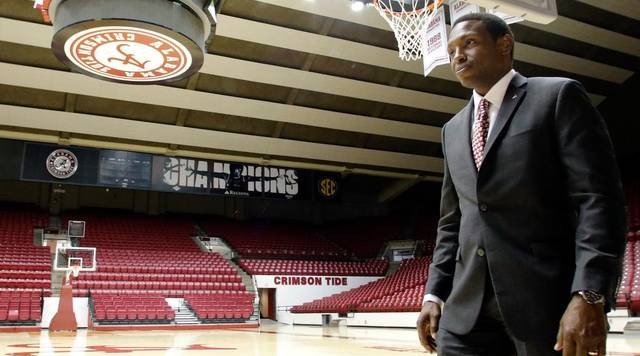The arrival of March — just a week away — means that coaching decisions will be met with a lot more scrutiny.
Let’s get into the habit, then, shall we?
Two coaches made the same basic mistake this past weekend, and while their teams were already likely to lose, their decisions turned defeat from a likelihood to a certainty.
Given the volatility of endgame college basketball, that’s a significant shift. Accordingly, these decisions represent errors which should not be casually shrugged off — not when the men committing these errors make seven-figure salaries.
Two men, two games, one shared error. Let’s examine what went wrong for Avery Johnson and Kevin Ollie on Saturday.
*
The Alabama Crimson Tide trailed the Mississippi State Bulldogs, 62-57, with 55 seconds left in regulation. Mississippi State had just snared a defensive rebound. With a 30-second shot clock, MSU had the ability to run the clock down to roughly 25 seconds. In a three-point game, allowing Mississippi State to play offense would be reasonable, especially if no opportunity existed to deny the ball to good foul shooters and consequently force a shaky free-throw shooter to step to the line. However, a five-point margin demanded that Avery Johnson foul MSU.
Let’s establish this principle right off the bat: The first priority for any team trailing by multiple possessions in the final two minutes: Extend the game. It’s conceptually simple, and not too hard to implement, either. Some concepts are conceptually simple but very hard to practice. This isn’t one of them.
It’s difficult enough for some NBA players to shoot free throws. Making college kids handle late-game heat at the not-always-charitable charity stripe should be a staple of endgame management for coaches. This is ever more the case when opponents are in the 1-and-1, not the double-bonus.
Yet, did Johnson do this against Mississippi State? No. The Bulldogs drained 27 seconds from the clock, and drained a jumper with 28 seconds left in the game, to gain a seven-point lead. Alabama was just about toast with 55 seconds left. The toast was done 27 seconds later.
*
In Cincinnati, the Connecticut Huskies were probably going to lose to the homestanding Bearcats. They trailed by a 60-54 score when Cincy got the ball back with 1:11 left. Surely, allowing UC to bleed 30 seconds from the clock, even without a make, would have dramatically narrowed UConn’s window of opportunity for a comeback. Making up a six-point deficit in 41 seconds is a daunting task. Even if you hit one three-pointer — which would likely require at least 10 to 15 seconds in a possession (after dribbling the ball upcourt and running an offensive action — you’re still going to have to foul with around 25 seconds left. Why not initiate that process of fouling earlier, when you can create many more exchanges of possessions?
Kevin Ollie did not choose this path. He allowed Cincinnati to hold the ball for 30 seconds. A made bucket at the shot-clock buzzer gave the Bearcats an eight-point lead with 41 seconds left. UConn was done.
The logic might be obvious to many, but let’s spell it out, since we’re giving this issue some treatment:
By saving 30 seconds, a coach can generally expect to create two more exchanges of possessions, three if his point guard is able to move the ball quickly enough down the floor. With two or three extra possessions, a team can gain seek quick twos and collect one-point advantages if the opponent splits a pair of free throws. More possessions can cut into the deficit without having to rely exclusively on three-pointers.
Fouling earlier rather than later achieves this basic purpose, which is connected to the notion of extending the game: Increase your options. If a team hits two free throws, yes, you’ll have to hunt the three at the offensive end, but if the opponent makes only one foul shot or misses a front end of a 1-and-1, a quick two works just fine. The key point: Fouling earlier creates situations in which you can choose an either-or path, depending on the result of the foul shot. The more chances for a plus-one-point exchange, the better.
*
Let’s conclude by acknowledging that both Avery Johnson and Kevin Ollie have coached well this season. Alabama has already surpassed expectations, while Connecticut is solidly within the NCAA tournament cut line and will almost surely get in. Both men are succeeding on a larger level.
Endgame management, however, is where they must improve. We’ll see how many of their brother coaches do (or don’t) handle that particular task in the coming weeks… and how severe the consequences will be for those which don’t make the right moves.

